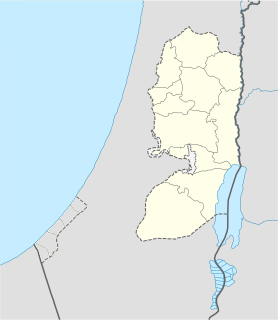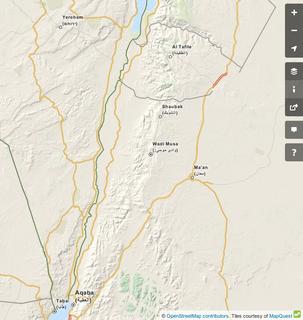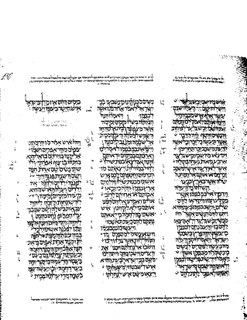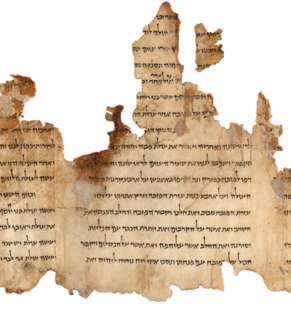
The Book of Joshua is the sixth book in the Hebrew Bible and the first book of the Deuteronomistic history, the story of Israel from the conquest of Canaan to the Babylonian exile. It tells of the campaigns of the Israelites in central, southern and northern Canaan, the destruction of their enemies, and the division of the land among the Twelve Tribes, framed by two set-piece speeches, the first by God commanding the conquest of the land, and, at the end, the last by Joshua warning of the need for faithful observance of the Law (torah) revealed to Moses.

The Book of Numbers is the fourth book of the Hebrew Bible, and the fourth of five books of the Jewish Torah. The book has a long and complex history, but its final form is probably due to a Priestly redaction of a Yahwistic source made some time in the early Persian period. The name of the book comes from the two censuses taken of the Israelites.

The Old Testament is the first part of Christian Bibles, based primarily upon the Hebrew Bible, a collection of ancient religious writings by the Israelites believed by most Christians and religious Jews to be the sacred Word of God. The second part of the Christian Bible is the New Testament.
Aholibamah, is an eight time referenced matriarch in the biblical record.
According to the Hebrew Bible, the Tribe of Reuben was one of the twelve tribes of Israel. Unlike the majority of the tribes, the land of Reuben, along with that of Gad and half of Manasseh, was on the eastern side of the Jordan. According to the biblical narrative, the Tribe of Reuben descended from Reuben, the oldest son of the patriarch Jacob. Reuben, along with nine other tribes, is reckoned by the Bible as part of the northern kingdom of Israel, and disappears from history with the demise of that kingdom in c. 723 BC.

The Samaritan Pentateuch, also known as the Samaritan Torah, is a text of the first five books of the Hebrew Bible, written in the Samaritan alphabet and used as scripture by the Samaritans. It constitutes their entire biblical canon.

The Horites, were a people mentioned in the Torah inhabiting areas around Mount Seir in Canaan.
According to the Hebrew Bible, the Jebusites were a Canaanite tribe who inhabited Jerusalem prior to the conquest initiated by Joshua and completed by King David. The Books of Kings as well as 1 Chronicles 11:4 state that Jerusalem was known as Jebus prior to this event. According to some biblical chronologies, the city was conquered by King David in 1003 BCE. The identification of Jebus with Jerusalem is disputed.
The Hittites, also spelled Hethites, were a group of people mentioned in the Hebrew Bible. Under the names בני-חת and חתי they are mentioned several times as living in or near Canaan since the time of Abraham to the time of Ezra after the return from the Babylonian exile. Their ancestor Heth is said in Genesis to be a son of Canaan, son of Ham, son of Noah.

Gibeon was a Canaanite city north of Jerusalem. According to Joshua 10:12 and Joshua 11:19, the pre-conquest inhabitants of Gibeon, the Gibeonites, were Hivites; according to 2 Samuel 21:2 they were Amorites.

Mount Seir, today known in Arabic as Jibāl ash-Sharāh, is the ancient, as well as biblical, name for a mountainous region stretching between the Dead Sea and the Gulf of Aqaba, demarcating the southeastern border of Edom with Judah. It may also have marked the older historical limit of Egypt in Canaan. A place called "Seir, in the land of Shasu", thought to be near Petra, Jordan, is listed in the temple of Amenhotep III at Soleb.
Nebaioth is mentioned at least five times in the Hebrew Bible according to which he was the firstborn son of Ishmael, and the name appears as the name of one of the wilderness tribes mentioned in the Book of Genesis 25:13, and in the Book of Isaiah 60:7.
The Perizzites are a group of people mentioned many times in the Bible as having lived in Canaan before the arrival of the Israelites. The name may be related to a Hebrew term meaning "rural person."

Mount Horeb, Hebrew: חֹרֵב, Greek in the Septuagint: χωρηβ, Latin in the Vulgate: Horeb, is the mountain at which the book of Deuteronomy in the Hebrew Bible states that the Ten Commandments were given to Moses by God. It is described in two places as הַר הָאֱלֹהִים the "Mountain of God". The mountain is also called the Mountain of YHWH.

Salah is an ancestor of the Israelites according to the Table of Nations in Genesis 10. He is thus one of the table's “seventy names.” He is called Shelah in 1 Chronicles 1:18 and Sala in the Septuagint and Luke 3:35.

2 Samuel 23 is one of the final chapters of the Books of Samuel in the Hebrew Bible. It contains a prophetic statement described as the "last words of David" and details of the 37 "mighty men" who were David's chief warriors.

Zephaniah 2 is the second chapter of the Book of Zephaniah in the Hebrew Bible or the Old Testament of the Christian Bible. This book contains the prophecies spoken by the prophet Zephaniah, and is a part of the Book of the Twelve Minor Prophets.
Isaiah 38 is the thirty-eighth chapter of the Book of Isaiah in the Hebrew Bible or the Old Testament of the Christian Bible. This book contains the prophecies attributed to the prophet Isaiah, and is a part of the Book of the Prophets.

Jeremiah 28 is the twenty-eighth chapter of the Book of Jeremiah in the Hebrew Bible or the Old Testament of the Christian Bible. The material found in Jeremiah 28 of the Hebrew Bible appears in Jeremiah 35 in the Septuagint. This book contains prophecies attributed to the prophet Jeremiah, and is one of the Books of the Prophets. This chapter contains a confrontation between prophets Jeremiah and Hananiah: Hananiah's false prophecy is responded by Jeremiah's answer, Jeremiah 28:1-9. Hananiah breaks Jeremiah's yoke, Jeremiah foretells an iron yoke, and Hananiah's death, Jeremiah 28:10-17.














